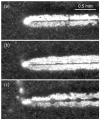Atmosphere Effects in Laser Powder Bed Fusion: A Review
- PMID: 39597373
- PMCID: PMC11595277
- DOI: 10.3390/ma17225549
Atmosphere Effects in Laser Powder Bed Fusion: A Review
Abstract
The use of components fabricated by laser powder bed fusion (LPBF) requires the development of processing parameters that can produce high-quality material. Manipulating the most commonly identified critical build parameters (e.g., laser power, laser scan speed, and layer thickness) on LPBF equipment can generate acceptable parts for established materials and moderately intricate part geometries. The need to fabricate increasingly complex parts from unique materials drives the limited research into LPBF process control using underutilized parameters, such as atmosphere composition and pressure. As presented in this review, manipulating atmosphere composition and pressure in laser beam welding has been shown to expand processing windows and produce higher-quality welds. The similarities between laser beam welding and laser-based AM processes suggest that this atmosphere control research could be effectively adapted for LPBF, an area that has not been widely explored. Tailoring this research for LPBF has significant potential to reveal novel processing regimes. This review presents the current state of the art in atmosphere research for laser beam welding and LPBF, with a focus on studies exploring cover gas composition and pressure, and concludes with an outlook on future LPBF atmosphere control systems.
Keywords: additive manufacturing; cover gas; laser powder bed fusion; pressure.
Conflict of interest statement
The authors declare no conflicts of interest. The funders had no role in the design of the study; in the collection, analyses, or interpretation of data; in the writing of the manuscript; or in the decision to publish the results.
Figures











References
-
- Liu R., Wang Z., Sparks T., Liou F., Newkirk J. Laser Additive Manufacturing. Elsevier; Amsterdam, The Netherlands: 2017. Aerospace applications of laser additive manufacturing; pp. 351–371. - DOI
-
- Guo N., Leu M.C. Additive manufacturing: technology, applications and research needs. Front. Mech. Eng. 2013;8:215–243. doi: 10.1007/s11465-013-0248-8. - DOI
-
- Oliveira J.P., LaLonde A., Ma J. Processing parameters in laser powder bed fusion metal additive manufacturing. Mater. Des. 2020;193:108762. doi: 10.1016/j.matdes.2020.108762. - DOI
-
- Oliveira J., Santos T., Miranda R. Revisiting fundamental welding concepts to improve additive manufacturing: From theory to practice. Prog. Mater. Sci. 2020;107:100590. doi: 10.1016/j.pmatsci.2019.100590. - DOI
Publication types
Grants and funding
LinkOut - more resources
Full Text Sources
Research Materials

